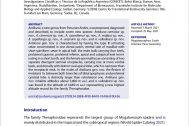Content
Antikuna, a new genus from Peruvian Andes, was proposed, diagnosed and described, to include seven new species: Antikuna cernickai sp. nov., A. cimrmani sp. nov., A. cyanofemur sp. nov., A. majkusi sp. nov., A. sapallanga sp. nov., A. urayrumi sp. nov. and A. valladaresi sp. nov. Antikuna gen. nov. is characterised by having the type III urticating setae concentrated in one dorsal patch, ventral side of maxillae with short spiniform setae in apical half, the male bulb carrying four keels, prolateral superior, prolateral inferior, apical and subapical keel terminating in a short tooth, and the female spermathecae consisting of two separate divergent seminal receptacles, carrying one or more ventral keels, and dorsally with distinct oval apical lobe, which is narrower than the receptacle neck. In the males of Antikuna gen. nov. the flexion of metatarsi I is between both branches of tibial apophyses and prolateral cymbial lobe is distinctly larger than retrolateral one. Antikuna gen. nov. inhabits altitudes above 3,800 m a.s.l. and A. valladaresi sp. nov. was found in the altitude of 4,689 m a.s.l. representing a new highest altitude record for the family Theraphosidae.



